#isabella d'este
Text


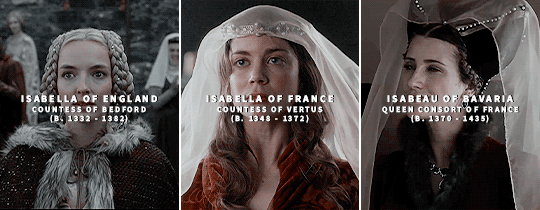



↳ Historical Ladies Name: Isabella/Isabelle
#isabella of gloucester#isabella of angouleme#isabella of england#isabella of aragon#isabella of france#isabella of valois#isabeau of bavaria#isabella of portugal#isabella i of castile#isabel neville#isabella d'este#isabella of austria#isabella of parma#historicalnames*#historyedit#my gifs#creations*
352 notes
·
View notes
Text


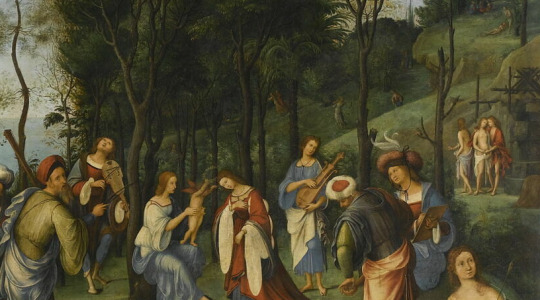
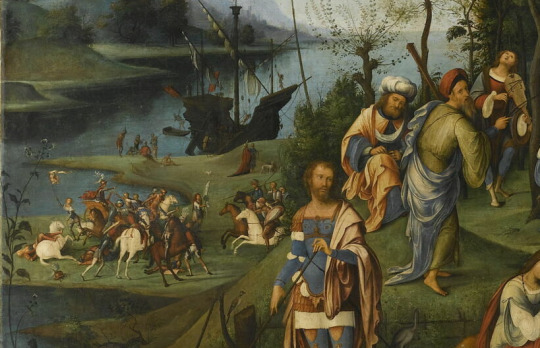
Allegory of Isabella d'Este's court, Lorenzo Costa, 1500-1525
#art history#art#italian art#aesthethic#painting#16th century#allegory#isabella d'este#este#court#rinascimento#lorenzo costa#louvre museum#fashion history
8 notes
·
View notes
Photo

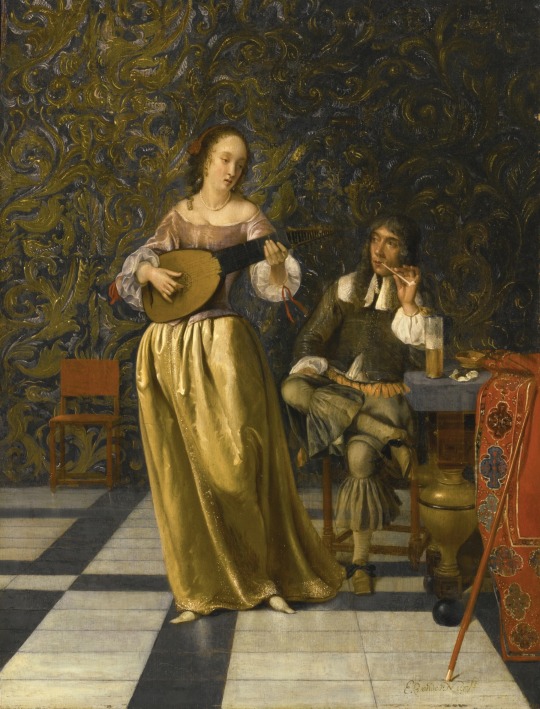


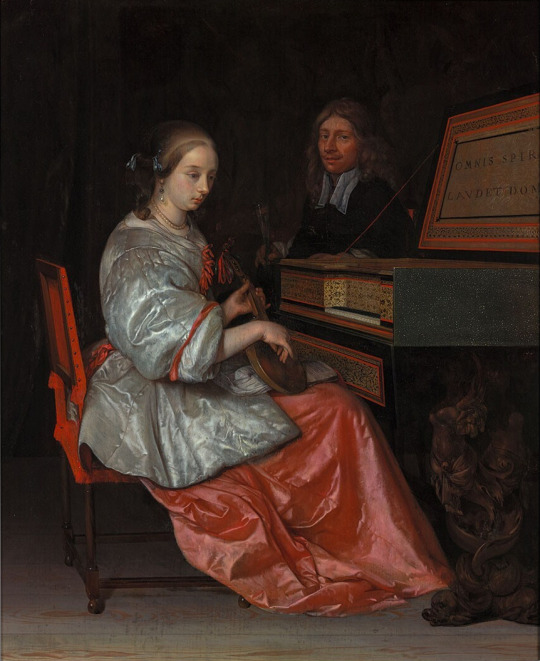
Back to the mid-1600s (from top to bottom) -
Woman Washing her Hands by Eglon van der Neer (Mauritshuis - Den Haag, Zuid-Holland, Netherlands). From pubhist.com/w40585 807X1000 @72 309kj.
ca. 1660 Lady playing a lute with a gentleman seated at a table in an interior by Eglon Hendrik van der Neer (Sotheby's - 28Jan16 auction Lot 28)2880X3782 @72 3.3Mj.
1665 La Grande Dame by Eglon Van der Neer (private collection). From Wijimedia; fixed some cracks, spots, & veiling reflections w Pshop 1721X2048 @72 1.7Mj.
ca. 1666-1670 Isabella d'Este by Frans Denys (Galleria Nazionale - Parma, Emilia Romagna, Italy). From tumblr.com/roehenstart; fixed spots w Pshop 1022X1280 @72 394kj.
1669 Woman at a virginal with a cittern on her lap, accompanied by a man by Eglon van der Neer (Museum Boijmans Van Beuningen - Rotterdam, Zuid-Holland, Netherlands). From Wikimedia 2802X3430 @72 2.1Mj.
#1600s fashion#Louis XIV fashion#Baroque fashion#middle 1600s fashion#1660s fashion#Eglon van der Neer#off shoulder neckline#petticoat#Eglon Hendrik van der Neer#paned sleeves#Isabella d'Este#Frans Denys#sheer bertha#jacket
76 notes
·
View notes
Text

Elisabetta Gonzaga was the daughter of the lord of Mantua and her early education led her to a life of companionship with some of the greatest minds of fifteenth-century Italy. She married Guidobaldo da Montefeltro, the duke of Urbino, in 1488, and thereafter her court attracted writers, artists, and scholars. She was also the sister-in-law of Isabella d’Este, the influential Renaissance patron and political figure. Elisabetta Gonzaga was immortalized by the writer Baldassare Castiglione, whose famous work, The Courtier, was based on his interactions and conversations with her.
She married Guidobaldo da Montefeltro, the duke of Urbino, in 1489. Guidobaldo was sickly and impotent, and they had no children, but Elisabetta refused to divorce him and nursed him through his illnesses. After his death, Elisabetta refused to marry.
Her court attracted writers, artists, and scholars. Her nobility gave her contact and involvement in the power politics of 16th century Italy. She was the sister-in-law of Isabella d'Este, an influential Renaissance patron and political figure. Despite having poor health, Elisabetta was known to be a great horsewoman and would frequently attend hunts in the countryside around Urbino.
In 1502 Elisabetta reluctantly accompanied Lucrezia Borgia on her journey to Ferrara, where Lucrezia was married to Alfonso I d'Este. An eyewitness described her at the wedding thus:
"On entering Ferrara she rode a black mule caparisoned in black velvet embroidered with woven gold, and wore a mantle of black velvet strewn with triangles of beaten gold; another day indoors she wore a mantle of brown velvet slashed, and caught up with chains of massive gold; another day a gown of black velvet striped with gold, with a jewelled necklace and diadem; and still another day, a black velvet robe embroidered with ciphers."
#perioddramaedit#history#edit#history edit#elizabeth olsen#elisabetta gonzaga#elizabetta gonzaga#rimini#donne nella storia#donne della storia#donne italiane#donneitaliane#italian renaissance#women of renaissance#renaissance italy#renaissance women#renaissance#rinascimento#mantua#isabella d'este#lucrezia borgia#16th century#baldassare castiglione#guidobaldo Montefeltro#women of history#historical women#strong women#cortegiania#italiansedit#italian history
36 notes
·
View notes
Text
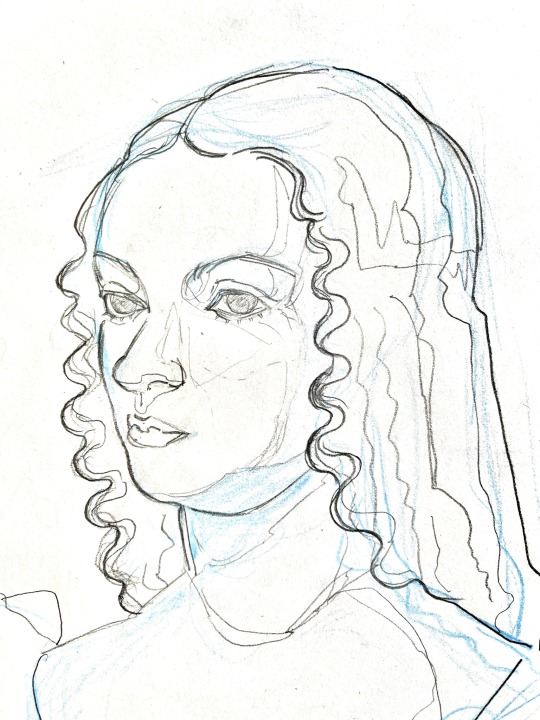
Afternoon sketch lest my fingers might crumple up.
#my art#sketchy poo#Referenced from Giovanni Cristoforo Romano's portrait of Isabella d'Este#in case anyone was wondering#probably incorrect usage of lest
4 notes
·
View notes
Text

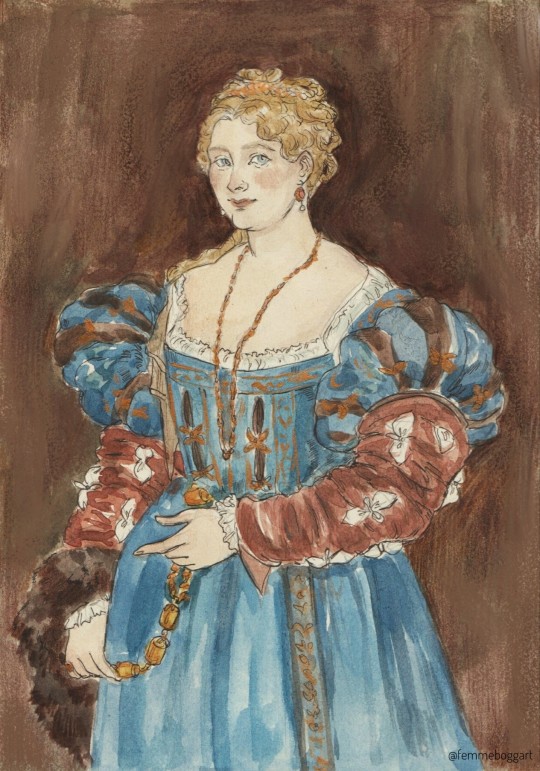
crowley and aziraphale inspired by titian female portraits –ritratto di isabella d'este and "la bella"
#good omens#crowley#aziraphale#good omens 2#my art#ineffablewives#aziracrow#fem! azicrow#renaissance#huh
67 notes
·
View notes
Text

Terracotta by Gian Cristoforo Romano, Bust of Isabella d'Este, c.1498
67 notes
·
View notes
Note
can you name all 59 women
1. Anne Bonny: a lesbian
2. Mary Read: a lesbian
3. Mary Read again: an abusive, cheating wife
4. Mary, Queen of Scots: a lesbian. (But also not a lesbian because Hester Mary MacKenzie was also her concubine.)
5. Isabella 'Bella' Baldwin: a lesbian
6. Queen Elizabeth of Parma, also known as Isabelle d'Este, was the Empress of Modena. She's one of several queens whose non-biological children were legitimized by the church.
7. Mary, Queen of France (before and during her marriage to Henry III).
8. Charlotte of Savoy: a lesbian
9. Elizabeth of York, also Elizabeth Stuart: a lesbian
10. Anna Ivanovna Demushkin: a lesbian (Ivan the Terrible's wife, as well as Mary Queen of Scots')
11. Mary, Duchess of Orleans: a lesbian
12. Mary, Duchess of Orleans again: a lesbian
13. Isabella of France: a lesbian
14. Margaret of Anjou, wife of Francis Plantagenet: a lesbian.
15. Mary 'Mary of Guise', daughter of Margaret of Anjou and Francis Plantagenet: a lesbian
16. Queen of Denmark: a lesbian (Anne's daughter, Sophie of Poland and Denmark)
17. Catherine Howard: a lesbian
18. Katherine Howard: a lesbian
19. Mary, Queen of England: a lesbian (Mary Tudor)
20. Eleanor of Austria, daughter of Ferdinand and Isabella: a lesbian (Mary Tudor's daughter, also Queen of England)
21. Mary, Queen of Bohemia: a lesbian
22. Catherine Parr: a lesbian
23. Eleanor of Austria, again: a lesbian (Mary Tudor's daughter, also queen of England)
24. Mary Tudor: a lesbian
25. Queen of Scots: a lesbian
26. Catherine Parr again: a lesbian
27. Christine de Bourgogne: a lesbian, as well as a queen of France.
28. Jane Seymour, wife of Thomas Seymour and mother of Edward Seymour. Also a lesbian.
29. Mary Stuart: a lesbian
30. Isabella of Castile: a lesbian
31. Mary Stuart again, daughter of Mary I of England: a lesbian
32. Jane Seymour again: lesbian (Edward Seymour's mom)
33. Anne Fitzwilliam, Duchess of Norfolk: a lesbian
34. Barbara Tacy, Countess of Pembroke: a lesbian
35. Mary Tudor again: a lesbian. (Mary Stuart's daughter again)
36. Jane Buckley: a lesbian
37. Catherine Parr: Elizabeth Howard, Parr's daughter, was Queen of England after her mother's death and died without an heir.
38. Margaret Cecil: a lesbian
39. Anna of Cleves: Anne Beaton, wife of Frederick V, Elector of Saxony and of James I and Mary, Queen of Scots; and her granddaughter, Lady Jane Grey, daughter of King Henry VIII and Edward Seymour.
40. Henrietta Maria Stuart: lesbian
41. Anne of Cleves: lesbian
42. Mary Queen of France: lesbian
43. Mary Queen of France again: a lesbian
44. Margaret, Countess of Lennox: lesbian
45. Elizabeth Howard: another lesbian
46.
Anne Stafford: a lesbian
47.
Jane Stafford: a lesbian
48. Jane Seymour again: a lesbian
49. Mary Stuart, Queen of Scots: lesbian
50. Princess Margaret: a lesbian
51. Anne of Cleves again, this time as a mother: Mary Tudor's daughter; Queen of England for less than a month in 1553
52.
Jane Stafford again: lesbian
53. Margaret Howard, Countess of Stafford: lesbian
54. Lady Jane Grey again: a lesbian
55. Princess Anne: a lesbian. (Princess of Portugal and the two Marianas, of Portugal and England.)
56. Elizabeth Howard again: lesbian
57. Margaret of Anjou, Lady of Woodville, wife of Ralph Neville, son of the Duke of Northumberland (Henry Tudor).
58.
159 notes
·
View notes
Text

Parnassus (also known as Mars and Venus, 1497 - Andrea Mantegna (1431–1506)
The Parnassus was the first picture painted by Mantegna for Isabella d'Este's studiolo (cabinet) in the Ducal Palace of Mantua. The shipping of the paint used by Mantegna for the work is documented in 1497; there is also a letter to Isabella (who was at Ferrara) informing her that once back she would find the work completed.
The theme was suggested by the court poet Paride da Ceresara. After Mantegna's death in 1506, the work was partially repainted to update it to the oil technique which had become predominant. The intervention was due perhaps to Lorenzo Leonbruno, and regarded the heads of the Muses, of Apollo, Venus and the landscape.
Together with the other paintings in the studiolo, it was given to Cardinal Richelieu by Duke Charles I of Mantua in 1627, entering the royal collections with Louis XIV of France. Later it became part of the Louvre Museum.
The traditional interpretation of the work is based on a late 15th-century poem by Battista Fiera, which identified it as a representation of Mount Parnassus, culminating in the allegory of Isabella as Venus and Francesco II Gonzaga as Mars.
The two gods are shown on a natural arch of rocks in front a symbolic bed; in the background the vegetation has many fruits in the right part (the male one) and only one in the left (female) part, symbolizing the fecundation. The posture of Venus derives from the ancient sculpture. They are accompanied by Anteros (the heavenly love), opposed to the carnal one. The latter is still holding the arch, and has a blowpipe which aims at the genitals of Vulcan, Venus' husband, portrayed in his workshop in a grotto. Behind him is the grape, perhaps a symbol of the drunk's intemperance.

Detail of Vulcan.
In a clearing under the arch is Apollo playing a lyre. Nine Muses are dancing, in an allegory of universal harmony. The touch of Pegasus's hoof (right) can generate the spring which fed the falls of Mount Helicon, which can be seen in the background. The Muses danced traditionally in wood of this mount, and thus the traditional naming of Mount Parnassus is wrong.

Detail of Pegasus and Mercury.
Near Pegasus is Mercury, with his traditional winged hat, caduceus (the winged staff with entwined snakes), and messenger shoes. He is present to protect the two adulterers.
#parnassus#mars and venus#anteros#mercury#venus#vulcan#roman mythology#andrea mantegna#italian artist#italian renaissance#15th century art#tempera and gold on canvas#mythological art#mythological painting#tempera painting#pegasus#greek mythology#musée du louvre#allegorical art#allegorical painting#apollo#the nine muses#mount helicon#art details
6 notes
·
View notes
Note
Etta tell me more about Viola’s story maybe???
Vilotta is the fictional youngest daughter of the real world historical figure Marchioness Isabella d'Este who ruled the Italian city state of Mantua from 1492-1539. In 1499, she commissioned Leonardo Da Vinci to paint a portrait of her, but it's questionable whether or not the painting was ever actually finished. She herself was a major cultural figure who had a classical education and patronized the arts and ran the city state in her husband's absence.

In my story, when Leonardo Da Vinci arrives in Mantua, Isabella decides to supplement her daughter's education with some hands-on experience. As her youngest daughter, she won't be expected to inherit the throne so she has more freedom than the other siblings, but she'll need a well-rounded education to hold her own as an adult in the court or to be equal to a future husband in a political marriage. So she sends the 12 year old Vilotta to study with Leonardo Da Vinci as an art apprentice.
At first, she's bored by crushing pigments and mixing paints for her eccentric mentor, but she takes an interest in his work after seeing diagrams of the flying machines in his notebooks. She also learns that there's quite a lot of chemistry in the materials of paint and learns that there isn't such a big difference between art and STEM after all. Between painting, they start working together on a glider, and despite her young age, she's a clever inventor in her own right, and together they make several improvements.
All this intro is original to the story I wrote when I was 13, but everything after this is new and also better than what 13yearold Etta could come up with:
Impatient to test it, Vilotta sneaks into their workroom one evening after they've finished painting for the day, opens the windows, and launches herself into the sky on her glider. Hurrah! It works! She causes a huge commotion as she lands safely in the fields around the castle, met by a joyful, worried, relieved, and angry Leonardo who's astounded by her recklessness and excited his invention works, but he's mostly just thrilled she's not dead.
But horror of horrors, when they return to the workshop, the gust of wind from the launch blew over all the carefully prepared pigments and ruined the weeks of work on the painting. Leonardo is irate and terrified he's going to be exiled for A) endangering the princess and B) not finishing yet another commission, so Vilotta decides to take matters into her own hands to fix her mistake, and flies off to collect replacement pigments before it's too late.
Queue a fetch-quest style adventure that leads Vilotta all over the city states of Renaissance Italy, narrowly avoiding danger from highway brigands who find out she's a lost princess and try to kidnap and ransom her, and rival military generals who try to steal her miraculous flying machine. I'm imagining this turns into a comedic "Home Alone 2: Lost in NYC" situation where a 12 year old girl with enough chemistry and mechanical engineering skills to hold her own keeps tricking her pursuers into increasingly slapstick-style antics as she escapes with her precious pigments.
This ends in a somewhat tense situation as she finally arrives back at home, enemies on her heels, and needs to own up to her mistakes and make amends with both her mentor and her parents, who have dispatched half the army to look for her at this point.
I just think it's a really fun idea that has a lot of potential as a vaguely educational adventure book that blends mechanical engineering, chemistry, art history, geography, politics, and various creative mediums. The D'Este family is well known enough that there's material to research but they're also not one of the Big Names most lay people know off the top of their heads, so it's a perfect place to play around and invent my own plausible fictional characters, like Vilotta.
7 notes
·
View notes
Text
Tudor/Renaissance book recs
@ziggy-scardust you asked for this on a post and I've finally got round to it :D
Here are my faves:
Tudor books
Anne Boleyn aka my fave
The life and death of Anne Boleyn by Eric Ives - I regard this as the AB bible it is so comprehensive (to the point where it can be a bit dense to read). But an amazing portrait of Anne as a politician who understood how fashion and taste created an image of power.
Anne Boleyn: 500 years of lives by Hayley Nolan - Really interesting exploration about how different periods of history interpret/demonise Anne.
Catherine Parr
Katherine the Queen by Linda Porter- An amazing book about how educated she was- fully challenges how history remembers her as the wife who was Henry's nursemaid when she was a political creature in her own right.
Renaissance books
Women in the Renaissance by Margaret L. King - A comprehensive look at the roles, expectations, and daily lives of women during the Renaissance.
Renaissance Woman: The Life of Vittoria Colonna by Ramie Targoff - A biography of Vittoria Colonna, a poet and a close friend of Michelangelo.
Lucrezia Borgia: Life, Love and Death in Renaissance Italy by Sarah Bradford.
The Lady of the Renaissance: A Portrait of Isabella d'Este by Julia Cartwright - This book delves into the life of one of the Renaissance's most famous women
Women in Italian Renaissance Culture and Society by Letizia Panizza- an amazing collection of essays
15 notes
·
View notes
Text

Andrea Mantegna, Parnassus, 1496-1497, tempera/canvas (Louvre, Paris)
One of the central paintings from the dismantled Studiolo of Isabella d'Este
33 notes
·
View notes
Text

Tiziano, Isabella d'Este, 1530-1539
4 notes
·
View notes
Text
The Roses cake is a typical dessert of the Mantuan culinary tradition. Its historical origins date back to the end of the fifteenth century. The roses cake was in fact created on the occasion of the wedding between Francesco II of Gonzaga and Isabella D'Este and was so appreciated by all the Lords of the time that from that moment entered in the Mantuan gastronomic culture and even today it is revived according to the ancient recipe. The roses cake is made with a leavened dough rich in butter and sugar that is rolled into the characteristic shape of a basket of rosebuds that gives the name to this tasty cake.
A tasty gift to offer to the mother on the occasion of her party!
#Cakes#Desserts#Pastry#cakes#dessert#follow4follow#food#foodporn#handmade#instaitalianlasagna#instafood#italian#italianpastry#italiantypicalcuisine#like4likes#pastry#sweetness#vegetarian
3 notes
·
View notes
